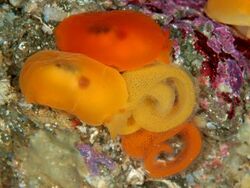Biology:Berthellina citrina
| Berthellina citrina | |
|---|---|

| |
| Scientific classification | |
| Domain: | Eukaryota |
| Kingdom: | Animalia |
| Phylum: | Mollusca |
| Class: | Gastropoda |
| Order: | Pleurobranchida |
| Family: | Pleurobranchidae |
| Genus: | Berthellina |
| Species: | B. citrina
|
| Binomial name | |
| Berthellina citrina (Ruppell & Leuckart, 1828)
| |
| Synonyms[1] | |
| |
Berthellina citrina, the orange gumdrop,[2] is a species of sea slug in the family Pleurobranchidae. It is found in rock pools in the intertidal zone and in shallow water in the tropical and subtropical Indo-Pacific region.
Description
Berthellina citrina grows to a maximum length of about 3 cm (1.2 in) and has a broadly ovate body. It varies in colour from a translucent pale yellow to a brick red. The head bears a triangular oral veil with a ventral groove, and a pair of rhinophores rolled into tubes. The surface of the mantle is studded with small white glands which produce a distasteful whitish secretion. The remnants of the shell are embedded in the mantle and the gut is visible through the overlying tissues.[3] There is a single gill located in a gap between the mantle and the foot on the right-hand side, with around twenty pectinate lamellae on each side.[citation needed]
Distribution and habitat
Berthellina citrina is a common species found throughout the tropical and subtropical Indo-Pacific, and as far south as New Zealand.[3] As well as being found in rock pools, it occurs on reefs and among boulders in the shallow subtidal zone, and down to a maximum depth of 150 m (500 ft). It is nocturnal and hides in crevices and under rocks during the day.[2]
Ecology
Sea slugs in this family mostly feed on sponges, and Berthellina citrina is no exception. In Hawaii, however, it has been observed feeding on the corals Tubastrea coccinea, Leptastrea sp. and Porites lobata,[3] and it also consumes detritus.[2] The glandular secretion is released when the mantle surface is stimulated and is acidic, containing chlorine and sulphate ions. It is used as a defence against predators, and in laboratory experiments repelled sea anemones, fish, and crustaceans.[4] Sea slugs in the Pleurobranchidae are hermaphrodites. The eggs are laid in an orange spiral jelly-like egg ribbon.[citation needed]
References
- ↑ Gofas, Serge (2020). "Berthellina citrina (Ruppell & Leuckart, 1828)". WoRMS. World Register of Marine Species. http://www.marinespecies.org/aphia.php?p=taxdetails&id=140815.
- ↑ 2.0 2.1 2.2 " Berthellina citrina (Ruppell & Leuckart, 1828)". SeaLifeBase. https://www.sealifebase.ca/summary/Berthellina-citrina.html.
- ↑ 3.0 3.1 3.2 Rudman, W.B. (9 March 1999). "Berthellina citrina (Ruppell & Leuckart, 1828)". Sea Slug Forum. http://www.seaslugforum.net/find/bertcitr.
- ↑ Marbach, A.; Tsurnamal, Moshe (August 1973). "On the biology of Berthellina citrina (Gastropoda: Opisthobranchia) and its defensive acid secretion". Marine Biology 21 (4): 331–339. doi:10.1007/BF00381090.
Wikidata ☰ Q5057929 entry
 |

